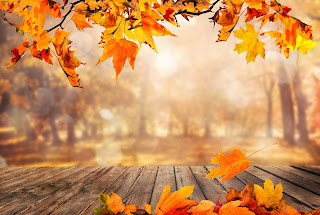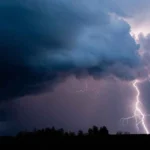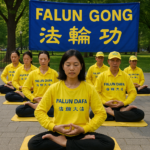
Wooden table with orange leaves autumn background
Autumn is one of the four temperate seasons on Earth. It is also known as fall in American and Canadian English. Outside of the tropics, autumn marks the transition from summer to winter, occurring in September (Northern Hemisphere) or March (Southern Hemisphere) (Southern Hemisphere). Autumn is the season when the daylight hours become noticeably shorter and the temperature drops significantly. As the season progresses until the Winter Solstice in December (Northern Hemisphere) and June (Southern Hemisphere), day length decreases and night length increases (Southern Hemisphere). One of its most noticeable features in temperate climates is the dramatic change in color of deciduous tree leaves as they prepare to shed.
Fall is the only season that has two names: spring, summer, and winter each have only one, whereas fall is also known as autumn. The season also had a third name in 12th and 13th century Middle English: “haerfest,” which was the act of taking in crops. It was eventually dubbed “harvest” because the full moon closest to the autumn equinox is known as the harvest moon.
Because there is less sunlight in autumn, the days are shorter and the nights are longer.
Autumn begins with the Autumn Equinox. Autumn lasts until December’s Winter Solstice.
On the Autumn Equinox, the sun rises perfectly in the east and sets perfectly in the west.
Seasons are opposite in the Southern and Northern Hemispheres. In the Southern Hemisphere, this means that autumn begins in March.
Autumn does not exist for people who live near the equator. The temperature remains nearly constant throughout the year.
The harvest moon occurs near the Autumn Equinox. Its bright moonlight assisted farmers in harvesting crops before electricity was available.
The weather cools down in autumn. This is why it is referred to as “sweater weather.”
Trick-or-Treating was inspired by a medieval tradition. People would dress up in spooky costumes and put on entertaining performances in exchange for treats. The eerie costumes were also thought to confuse and repel demons.
Scarecrows have been used to protect crops for thousands of years.
The first frost can arrive in autumn. This is when water from the air falls to the ground and freezes. A frosty morning foreshadows how lovely the upcoming winter weather will be.
Acorns are oak tree fruits that contain a single seed. They begin to fall in September and October.
Animals alter their behavior in the autumn to prepare for winter.
Hibernating animals such as bears, bats, skunks, chipmunks, and groundhogs will consume a large amount of food. Their extra body fat keeps them warm and gives them energy.
Snakes look for dens to live in during the winter in the autumn. To keep warm, different types of snakes will even share a den.
Furry animals’ fur thickens in autumn to keep them warm during the winter. This is referred to as their winter coat.
Fall is a busy time for bees. They must produce and store enough honey for the winter.
In the autumn, monarch butterflies will migrate from the United States to Mexico.
During the autumn season, you may notice more spiders, which may appear larger. That’s because the spring-hatched baby spiders have matured. Spiders are more active and scampering around during their mating season in autumn.
Owls hoot louder in the fall as they look for a place to nest during the winter.
When squirrels hide nuts for the winter, their brains grow larger. This aids in their memory of where they hide their food.
All of the hidden nuts that squirrels can’t find contribute to forest regeneration.
Bodies of water begin to cool down in the autumn. Fish can begin to explore areas of water that have been too warm all summer.
In the autumn, birds migrate to warmer climates. They migrate because cold weather means fewer seeds and insects to eat.
Trees that lose their leaves in the fall have a unique name. They are known as deciduous trees.
The chemical chlorophyll gives leaves their green color. In autumn, leaves receive less sunlight and stop producing chlorophyll.
The leaves finally turn their true colors in autumn. In the spring and summer, the true colors are hidden behind the green.
Because of the sugar, autumn leaves are also different colors. Sugar from the tree accumulates in the leaves. More sugar results in more vibrant red and purple colors.
Fall leaf colors are caused by the same pigments that give vegetables their various colors, such as orange carrots.
Climate change also has an impact on leaves. They do not change colors as quickly if the temperature remains too high.
It is beneficial to spend time in the presence of trees. Spend some time admiring the beautiful autumn leaf colors or stepping on crunchy dry leaves.
The dead leaves on the ground protect seeds during the winter. They also aid in the protection of underground bee nests.
Pumpkins are used to commemorate autumn. Many people enjoy eating pumpkin pie, going to pumpkin patches, carving pumpkins, and smelling pumpkin-spice scented candles.
Many popular fall fruits contain a lot of air. This explains why pumpkins, apples, and cranberries float in water.
Pumpkins are squash, and all squashes are fruits. That means pumpkins are actually a type of fruit.
Apples are a popular fall fruit because they are harvested in late summer and early autumn.
Flowers give rise to pumpkins.
Cranberries are another popular autumn fruit. Farmers flood the cranberry field to harvest the berries. The water is stirred and the berries are knocked off the vine using special equipment. The cranberries then float to the surface.
The Autumn Equinox occurs around September 22nd and marks the beginning of the days becoming shorter than the nights.
Diwali, the Hindu Festival of Lights, is celebrated in October or November with family and friends gathering around food and fireworks.
Indigenous Peoples Day honors and celebrates Native Americans and all they have contributed to American culture.
Halloween originated as an ancient harvest season celebration.
Carving pumpkins evolved from an Irish tradition of carving turnips or potatoes. The tradition was brought to America by Irish immigrants.
The first Thanksgiving was three days long. The first Thanksgiving was held to commemorate the first successful corn harvest of the pilgrims.









